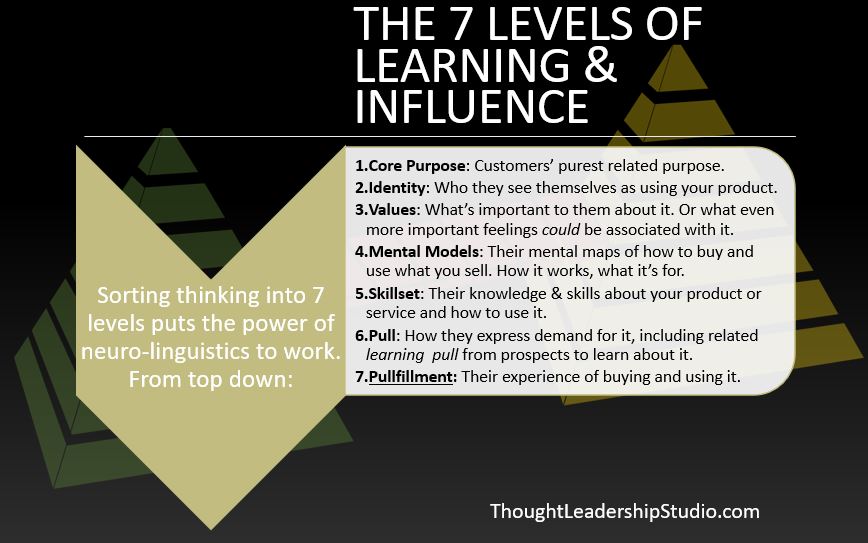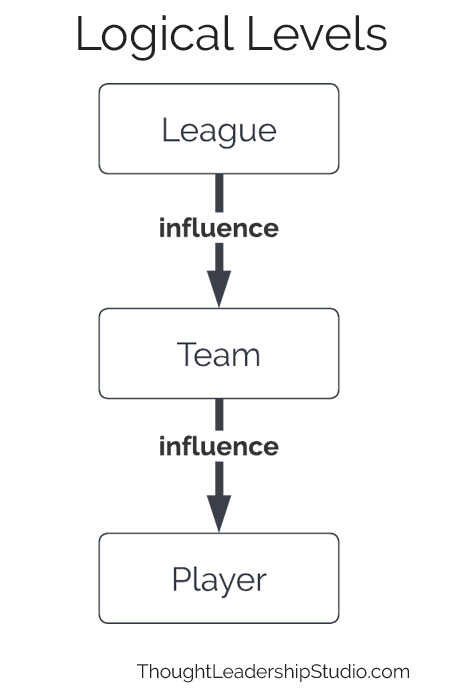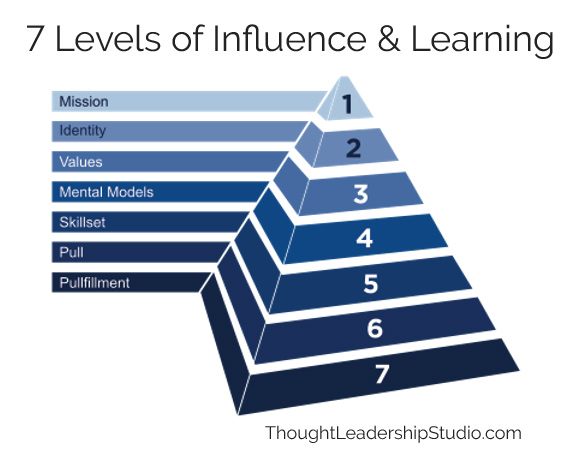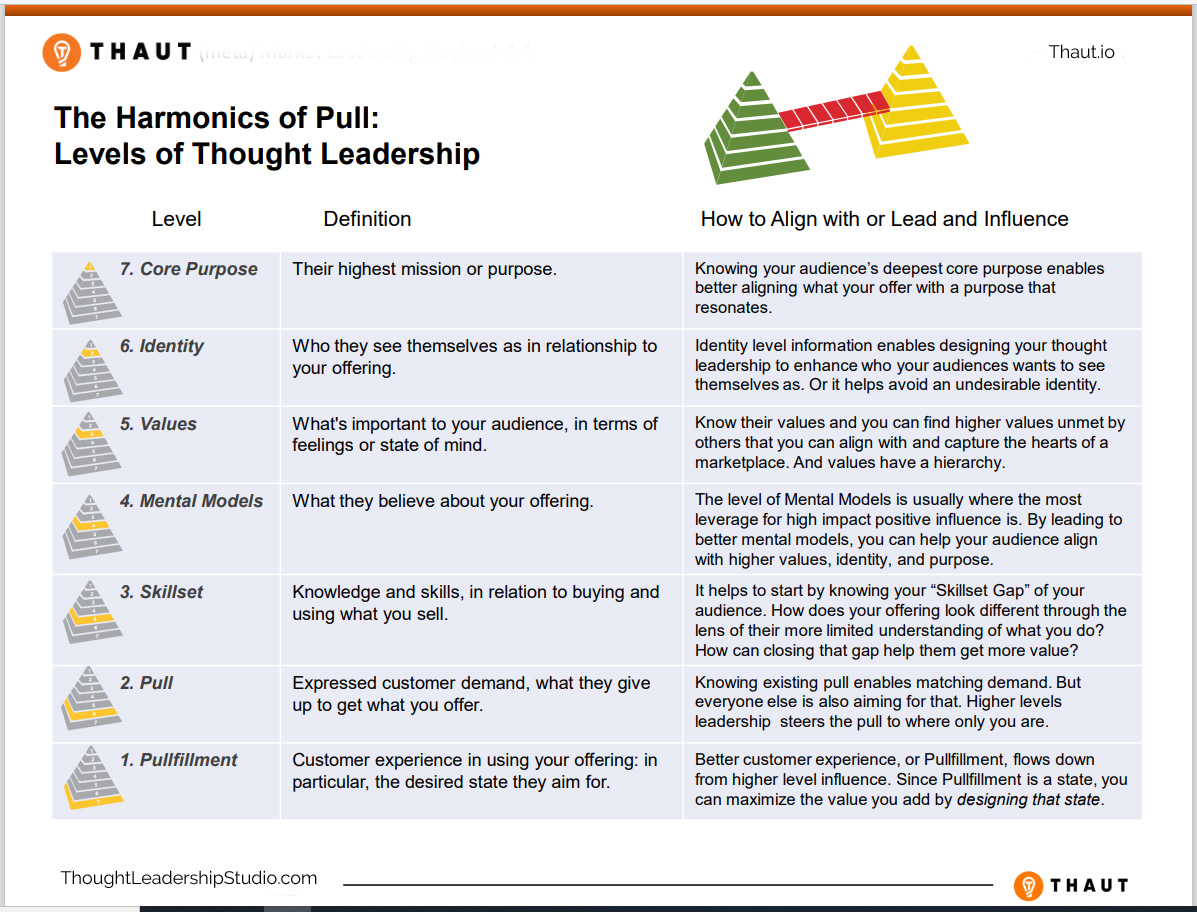Thought Leadership Studio Blog Posts:
The 7 Levels of Learning and Influence
Know what level you Influence on to maximize your positive impact. Tap into the power of higher level influence and higher level learning.

#innovation, #insight, #marketing, #marketingstrategy, #marketresearch, #massinfluence, #neurolinguisticprogramming, #nlp, #paradigms, #persuasion, #pullfillment, #strategicthoughtleadership, #systemsthinking, #thoughtleadershipmodel, #workshop
 Imagine it is medieval Europe and you are a messenger carrying an urgent message from a Duke. You're approaching the imposing castle of the feudal lord it is intended for. As the clomping of the horses' hooves slows to a pause, your neck aches from the stretch to fully take in the peaks of the stone towers.
Imagine it is medieval Europe and you are a messenger carrying an urgent message from a Duke. You're approaching the imposing castle of the feudal lord it is intended for. As the clomping of the horses' hooves slows to a pause, your neck aches from the stretch to fully take in the peaks of the stone towers.
How to deliver your message?
Given the castle is surrounded by a water-filled moat, you'll have to get the knights to lower the drawbridge. Ground level is typically heavily fortified. The message won't get there unless you can enter at the correct level.
Similarly, if you want to maximize your impact on the thinking of your audience, you need to approach them at the right level of thinking. Your message will get blocked in the minds of your audience as if by a castle's stone wall if you don't aim it at the level where it will have impact.
Parsing thinking into levels is what enables us to be strategic with thought leadership, for the mutual benefit of our audience and ourselves.
In this post, I aim to empower both your insight and your influence by introducing the Thaut Process 7-Levels of Influence and Learning Model. Why go to the trouble of sorting audience thinking into Levels?
- An increased ability to change minds. Your communication has more impact when you aim it at the right level.
- Deeper engagement. It helps you create and stay in rapport with your audience as you lead them to new thinking. There are levels you want to align with that will pace your audience and deepen your relationship with them.
- There are other levels that are ripe for change through positive influence, however, and this approach helps identify them.
- As I will demonstrate, attuning to and working with levels of learning and influence brings insight into market opportunities that won't reveal themselves with the typical Big Data approach, which assumes the past will repeat itself. Rather, this approach helps discover opportunities for a vision of the future you can lead your audience to that will resonate.
- The ability to discover opportunities for Strategic Thought Leadership can also be used for new product and service development. It can help discover what new features for an existing product or service will have the most positive impact.
"So...", the reader might think at this point, "...that is interesting - and maybe very helpful if true. But how can I trust this system of levels? Where did it come from?"
The Roots
Bateson's Logical Levels.
Gregory Bateson, a noted linguist, cyberneticist, and social scientist, was the author of Steps To An Ecology of Mind and Mind and Nature. He noted the insight that a set of members cannot be a member of itself. It is at what he called a higher logical level.
It's like how a player on a football team isn't a team. And a team is not a league...it's a member of a class called a "league."
And here is an important point we will keep returning to: Influence flows down logical levels but not up the same way.
If you make a change in a specific level, it impacts all the levels beneath it but not those above it.
 If a team changes its practice routines, that will impact the players. But if an individual player within a team changes their performance within their practice, it doesn't impact the team the same way. It can have some impact, in this case, but if an individual player can't meet the criteria of belonging to a team, that individual will tend to get replaced by another who can.
If a team changes its practice routines, that will impact the players. But if an individual player within a team changes their performance within their practice, it doesn't impact the team the same way. It can have some impact, in this case, but if an individual player can't meet the criteria of belonging to a team, that individual will tend to get replaced by another who can.
The team, being at a higher logical level, supersedes the player.
If a league changes the rules of the game, then it impacts every member of that set - every team. But a team changing its practice routines doesn't have that kind of global influence on the league.
Robert Dilts, an early leader in NLP and author of many books, saw a way to apply this to human neurology. I have found his model called Neurological Levels very useful for communication. Now we can think about "levels of influence" that impact all the levels underneath them similarly to how a football league changing the game rules impacts every team in the league ... and all the players on those teams.
We can also identify higher level blocks to change that will not respond well to influence aimed at lower levels. That is analogous to how a league-wide rule could keep individual teams and players from doing something they might otherwise do to improve their odds of winning.
Thinking about learning and leading in terms of logical levels gives meaning and power to the phrase "higher level influence".
Let's examine Dilts' model in more detail.
Dilts' Neurological Levels Model
Dilts translated Bateson's insights into what he called "Neurological Levels" as a way to parse levels of change within a person.
Neurological Levels:
- Mission
- Identity
- Values and Beliefs
- Capabilities
- Behavior
- Environment
As with Bateson's model, each level impacts all the levels underneath but not those above it.
Dilts eloquently describes how to apply the various levels to coaching in his book From Coach to Awakener. The Neurological Levels model has also been effectively applied in NLP methods for performance enhancement and greater congruence like the "Walking Levels of Change" method.
So how does this apply to leadership and influence? Translating to a Thought Leadership and Marketing context
Dilts' model is insightful but it still isn't ideal for strategic thought leadership. Hence, the audience-centered Thaut Process and its 7 Levels of Learning and Influence.
Without further ado, here they are:
Thaut Process 7 Levels of Learning and Influence
- Core Purpose: The highest positive related mission.
- Identity: The sense of "who am I" in relation to your product, service, field, or profession.
- Values: What's important? ... in terms of feelings. Higher Values are more universal, positive, and immutable. We could even evoke Jung's concept of archetypes for them.
- Mental Models: Our maps of the world. What does your audience believe about what you offer?
- Skillset: What are your prospects' abilities to use what you sell? What are their relevant knowledge and skills?
- Pull: Expressed customer demand for what you offer, like spending money for it.
- Pullfillment: The experience of the customer using the product or service
I will simply call it the "7 Levels Model" for short going forward, but it is also known as the "Pullamid" or 7-level Pyramid of Pull.

Pullamid = Pyramid of Pull = 7 Levels of Learning and Influence
Some of the levels are roughly equivalent to those of Dilts' Neurological Levels. Some differences are due to the purpose of the 7 Levels Model. It is more attuned specifically to the context of influencing a larger audience we serve, like a market segment.
Hence, rather than "environment", the lowest level is called "Pullfillment": the fulfillment of the pull of the level above it. Think of pull as the actions customers take to satisfy their needs and Pullfillment as their results from doing so.
Skillset is roughly equivalent to Dilts' capabilities level and it refers to the audience's ability to maximize the benefits they pull for. Could they get more of what they want with a higher knowledge or skill level?
The biggest difference is the 7 Levels models splits values and beliefs into 2 levels. There is a significant reason for that.
I understand where Dilts was coming from. In a sense, a value is a kind of belief - it's a belief about what is important.
But we separate those for utility in our influence model, because, in most cases, we want to:
- Align with values ... especially "higher values".
- Lead to new mental models (AKA beliefs).
We split things there because that is generally the highest point of impact: Influencing people on the level of mental models is a leverage point.
This is further validated by Systems Thinking.
In Donella Meadows' highly regarded treatise "Leverage Points: Places to Intervene in a System" the highest leverage points are about changing paradigms- either in attaining the freedom from paradigms (a very lofty goal, perhaps equivalent to spiritual enlightenment) or, more reasonably, in changing the related paradigms of those who control the system.
A paradigm is simply a more universally applied mental model. So, the mental models level is where we apply influence.
But we aren't just randomly choosing new mental models to replace old ones. The level above - Values - can serve as our guide to the utility of a new mental model replacing a prevalent one in our audience.
What makes a new mental model - which we are to call a Thought Leadership Position - better than the old one is that it better satisfies Higher Values identified on the level above.
A new mental model that enables better expression of important values creates greater alignment in an audience generally, or in an individual specifically.
By "opening up" a values bottleneck, there is a greater sense of flow through all the levels beneath, culminating in Elevated Pullfillment.
The Pull for Pullfillment and its relationship to higher levels.
Pullfillment
The definition of Pullfillment is "customers’ experience of receiving the value they pulled for." On one side of the Pullfillment equation is the quality of Pullfillment: How deeply is the value they aim to satisfy fulfilled?
What is their level of enjoyment, security, happiness? Have we helped them connect a new value to what we offer through our thought leadership? Or, have we helped them satisfy an already-connected value at a higher level?
Pull
The other side of the Pullfillment equation: How hard do they have to pull for a given Pullfillment? How much friction is in their path? How much time, effort, and money to get what they value? Pull is expressed customer demand: how much they spend, how much time they invest, how much energy they expend to get value.
Your offer should represent good value so you can work it from either end or both: 1- Increase Pullfillment with an enhanced customer experience- one that better resonates with their Values, or 2- Reduce the necessary Pull to get that Pullfillment.
Skillset
Are specialized skills or knowledge necessary to extract the value of your product or service? Does your field require expertise to participate? Many thought leaders aim to merit the title by helping expand their audience's skillset: "If you learn X, you will get more out of Y."
But, as we are seeing, there are yet higher levels of influence.
Mental Models
As mentioned above, this is the level we usually aim to influence because, as Meadows pointed out, it is a prime leverage point for making positive change. A mental model, being another moniker for belief or belief system always has an "if-then" statement behind it and this is the format that enables our applying various influence techniques that can provide fuel for PR, content marketing, or leadership.
Once we have designed a clear path from old mental model to new mental model and applied various NLP methods that generate persuasive talking points, we have powerfully answered the question "what to say " in our web content.
Values
Values are feeling words that describe what is important to your audience. This is a level that benefits from discovery and alignment. We want to discover values in our audience that could be firmly associated with our offering but are not yet... and get them aligned with a new, more empowering, mental model that defines our Thought Leadership Position.
Identity
Who does your audience see themselves as when they use what you sell? Would you want to lead them to a broader or different sense of identity associated with it? Or, and more likely, can this be used as leverage for a powerful Thought Leadership Model?
Core Purpose (Mission)
What is the highest overriding purpose of your audience as they currently use what you provide? How does adopting a particular Thought Leadership Position (via a new mental model you lead them to) help strengthen an audience's sense of purpose?

Consider the 7 Levels Model in relation to your audience.
- Can you identify some Values they presently connect to what you do or represent?
- What are their prevalent Mental Models? In other words, how do they perceive how it fits in their lives? What it does for them? How to best utilize it?
- Can you think of one or more enhanced Mental Models that would help them better fulfill a value they already connect to it?
- Can you express those Mental Models as "if-then" statements?
- Can you see how the right, new Mental Model could help them connect an important Value that they don't currently connect to what you do or represent?
- Are you beginning to see how this process can lead to formulating powerful Thought Leadership Positions that will resonate with an audience and lead to higher impact communication that moves them?
- Can you see how it will increase their Pull for a related offering with the promise of Elevated Pullfillment?
- Are you beginning to realize this can greatly assist answering the all-important question in every content marketer and thought leader's mind: "What content?"?
Do you notice any prevalent paradigms worth questioning and developing alternatives to? Would you put the Big Data Target-Marketing Paradigm in that category? If so, what would be an alternative Mental Model?
***************************************